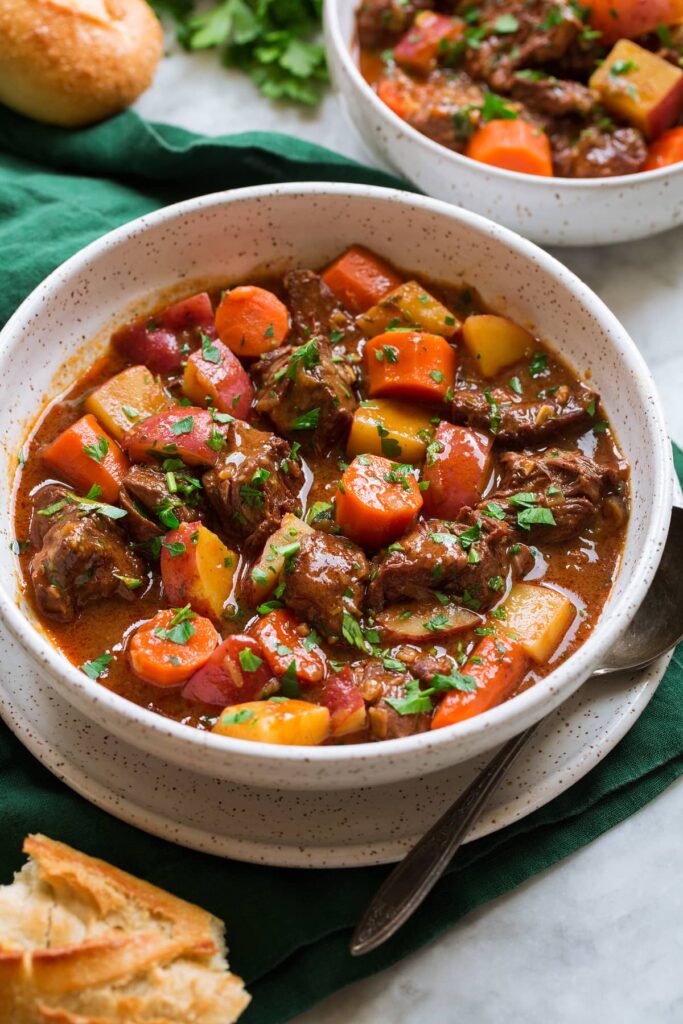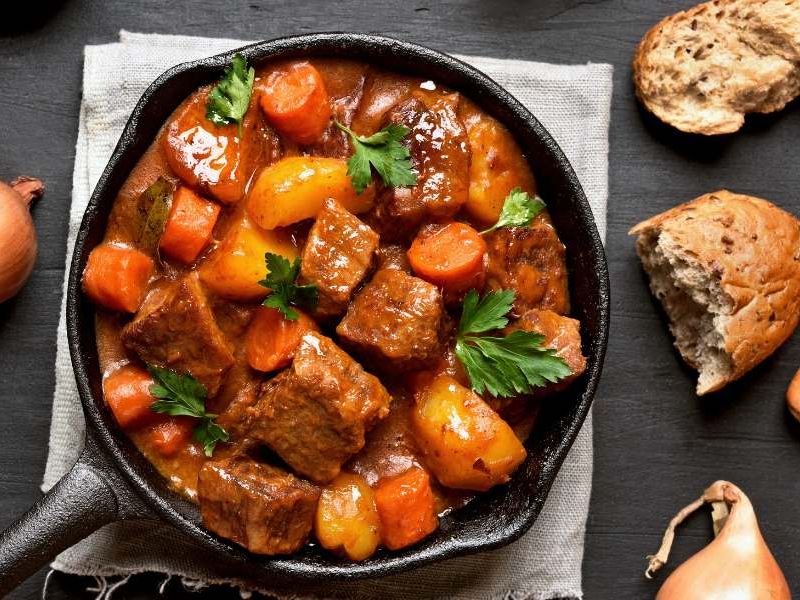Can You Freeze Beef Stew? How To Freeze Beef Stew?
Freezing beef stew is a convenient and practical way to extend its shelf life and ensure you always have a delicious meal on hand. Whether you have leftover homemade beef stew or you want to prepare a batch in advance for future use, freezing can help you save time and reduce food waste.
In this comprehensive guide, we will address common questions and concerns about freezing beef stew, including the inclusion of potatoes, the best way to freeze it, and how long it can last in both the freezer and the fridge.
Can You Freeze Beef Stew?
Beef stew is an ideal candidate for freezing.
The combination of tender beef, flavorful broth, and hearty vegetables makes it a versatile and satisfying dish that can withstand freezing and thawing without compromising its taste and texture.
Freezing beef stew allows you to make larger batches and portion them for later use, saving you both time and effort in meal preparation.
Can You Freeze Beef Stew with Potatoes in It

Potatoes are a common ingredient in beef stew, and you might be wondering if they can be successfully frozen alongside the other components.
The good news is that potatoes can indeed be frozen in stew, but some considerations should be taken to maintain their quality.
Potatoes have a high water content, which can cause them to become mushy or grainy after freezing.
To minimize this, it’s recommended to slightly undercook the potatoes before adding them to the stew.
This will help them retain some texture and prevent them from turning into an undesirable consistency upon thawing and reheating.
Can You Freeze Homemade Beef Stew?

Homemade beef stew is a labor of love, and freezing it can be a great way to enjoy the fruits of your culinary efforts later on.
The advantage of freezing homemade beef stew is that it allows you to preserve the flavors you’ve carefully developed during the cooking process.
When properly stored, frozen homemade stew can taste just as delicious as when it was freshly made.
Benefits of Freezing Beef Stew
Convenience and Time-Saving
Freezing beef stew provides exceptional convenience and time-saving benefits for busy individuals:
- Meal Preparation in Advance: By freezing beef stew, you can prepare a large batch of the dish ahead of time and have it readily available for future meals.
- Quick and Easy Reheating: Frozen beef stew can be conveniently reheated whenever you need a delicious and satisfying meal, saving you precious time in the kitchen.
- On-Demand Availability: With frozen beef stew, you always have a homemade meal on hand, eliminating the need for last-minute takeout or meal planning stress.
Preserving Freshness and Flavor
Properly freezing beef stew helps maintain its freshness, flavors, and textures, ensuring a delightful culinary experience:
- Retaining Nutritional Value: Freezing preserves the nutritional content of the beef stew, allowing you to enjoy a well-rounded and nourishing meal.
- Locking in Flavors: When frozen, the flavors of the beef stew are preserved, and they can be enjoyed just as if the stew was freshly cooked.
- Preventing Spoilage: Freezing prevents bacterial growth and spoilage, extending the shelf life of the beef stew and reducing the chances of food waste.
Reducing Food Waste
Freezing beef stew is an effective way to reduce food waste and make the most of your ingredients and leftovers:
- Preserving Leftovers: If you have leftover beef stew, freezing it ensures that it doesn’t go to waste and can be enjoyed at a later time.
- Portion Control: By freezing the stew in smaller portions, you can thaw and reheat only what you need, minimizing food waste and optimizing portion sizes.
- Cost Savings: By freezing beef stew, you can make the most of bulk purchases or sales, saving money by utilizing ingredients efficiently and avoiding unnecessary food expenses.
How Long Can You Freeze Beef Stew?
The length of time you can freeze beef stew depends on various factors, such as the ingredients used, the storage conditions, and the quality of the stew before freezing.
In general, beef stew can be frozen for up to 3 months while maintaining good quality. After this period, the stew may still be safe to eat but could experience a decline in flavor and texture.
To ensure the best taste and texture, it’s recommended to consume the frozen beef stew within the first 3 months of freezing.
Best Way to Freeze Beef Stew

To maximize the quality and longevity of frozen beef stew, it’s important to follow the best freezing practices. Here’s a step-by-step guide:
- Allow the stew to cool: Before freezing, let the stew cool completely to room temperature. This prevents condensation and ice crystals from forming during the freezing process.
- Choose appropriate containers: Use freezer-safe containers or resealable freezer bags that are sturdy and airtight. Ensure they are labeled with the date of freezing for easy identification later.
- Portion the stew: Divide the stew into smaller portions according to your future needs. This allows for easier thawing and prevents unnecessary waste.
- Remove excess air: If using resealable freezer bags, remove as much air as possible before sealing them. This helps prevent freezer burn and maintains the stew’s quality.
- Seal and freeze: Close the containers tightly or seal the freezer bags securely. Place them in the freezer, ensuring they are arranged in a way that allows for efficient airflow and avoids crushing or spilling.
By following these steps, you can maintain the flavor, texture, and overall quality of your beef stew throughout the freezing process.
How Long Will It Last in the Fridge?
If you choose to store beef stew in the refrigerator instead of the freezer, it’s important to know how long it will remain safe to eat. When stored properly in an airtight container, beef stew can last for 3 to 4 days in the fridge.
It’s crucial to keep the stew at a consistent temperature below 40°F (4°C) and practice good food hygiene to prevent any bacterial growth or spoilage.
How Long Can You Freeze Cooked Beef Stew?
If you have already cooked beef stew and want to freeze the leftovers, you can do so successfully.
Cooked beef stew can be frozen for the same duration as fresh beef stew, which is up to 3 months.
Ensure that the cooked stew is cooled, portioned, and stored in appropriate freezer containers following the aforementioned guidelines.
When reheating frozen cooked beef stew, it’s advisable to thaw it in the refrigerator overnight before gently reheating it on the stovetop or in the microwave.
Thawing and Reheating Frozen Beef Stew
Methods for Safely Thawing Beef Stew
Thawing frozen beef stew properly is crucial to maintain its quality and ensure the safety of the food. Here are some effective and safe methods for thawing beef stew:
- Refrigerator Thawing: The recommended approach is to transfer the frozen beef stew from the freezer to the refrigerator and allow it to thaw slowly overnight. This gradual thawing process helps preserve the rich flavors and delightful textures of the stew while preventing the growth of harmful bacteria.
- Microwave Thawing: If you’re pressed for time, you can use the defrost function on your microwave to thaw the beef stew. It’s important to follow the manufacturer’s instructions and periodically check the stew to ensure it thaws evenly without starting to cook in certain spots. By using this method, you can significantly reduce thawing time while still maintaining a satisfactory taste.
- Cold Water Thawing: In situations where you need to thaw the stew quickly, the cold water thawing method can come to the rescue. Simply place the sealed container of beef stew in a sink or large bowl filled with cold water. Remember to change the water every 30 minutes to keep it cold and continue the thawing process. It’s crucial to avoid warm or hot water, as it can promote the growth of harmful bacteria, compromising food safety.
Reheating Options for Beef Stew
Once the beef stew is properly thawed, you have several options for reheating it to serve a piping hot and delicious meal:
- Stovetop Reheating: Place the thawed beef stew in a saucepan or pot and heat it over medium-low heat on the stovetop. Stir occasionally to ensure even heating and prevent any sticking. If necessary, you can add a small amount of water or broth to maintain the desired consistency of the stew.
- Microwave Reheating: Transfer the thawed beef stew into a microwave-safe dish and cover it with a microwave-safe lid or microwave-safe plastic wrap. Reheat the stew in short intervals, stirring in between, until it reaches the desired temperature. It’s important to exercise caution and avoid overheating, as this can lead to a dry or unevenly heated stew.
- Oven Reheating: If you have a larger portion of beef stew to reheat, using the oven can be an excellent option. Preheat the oven to a low temperature, approximately 300°F (150°C). Place the stew in an oven-safe dish, cover it with foil to retain moisture, and heat it until warmed through. Stir the stew occasionally during the reheating process to ensure even distribution of heat.
Ensuring Proper Heating Temperatures
When it comes to reheating beef stew, it is of utmost importance to ensure that it reaches a safe internal temperature in order to eliminate any potential foodborne bacteria that may be present. To achieve this, follow these guidelines:
- Minimum Internal Temperature: Make it a priority to heat the beef stew to an internal temperature of at least 165°F (74°C) throughout. To accurately measure the temperature, it is advisable to use a food thermometer, which will provide precise readings.
- Stirring for Even Heating: While reheating the stew, it is recommended to stir it occasionally. This will help distribute the heat evenly, ensuring that there are no cold spots that might harbor harmful bacteria.
- Hot and Bubbly: A reliable indicator that the reheated beef stew has reached the appropriate temperature for safe consumption is when it becomes hot and starts bubbling. The presence of bubbling indicates that the stew has been thoroughly heated and any potential bacteria have been effectively eliminated.
FAQs about Freezing Beef Stew
Can you freeze beef stew that has been previously frozen?
It’s generally safe to freeze beef stew that has been previously frozen, but it’s important to consider the overall quality. Each time the stew goes through the freezing and thawing process, it may experience a slight decline in taste and texture.
Can you freeze beef stew with dairy-based ingredients?
Dairy-based ingredients, such as cream or milk, may not freeze well and can separate or become grainy upon thawing. It’s recommended to add dairy-based ingredients after reheating the frozen beef stew.
Can you freeze beef stew with noodles or pasta?
Noodles or pasta can become mushy and lose their texture when frozen and reheated in stew. It’s best to omit noodles or pasta from the stew before freezing and cook them separately when serving.
Can you freeze beef stew without vegetables?
While beef stew without vegetables can be frozen, the addition of vegetables enhances the overall flavor and nutritional value. Freezing beef stew with vegetables is generally recommended for a well-balanced meal.
Conclusion
Freezing beef stew is a practical way to ensure you always have a satisfying meal ready when you need it. Whether you have a homemade beef stew or leftovers from a delicious dinner, knowing how to freeze and store it properly will help maintain its taste and quality.
By following the guidelines outlined in this comprehensive guide, you can confidently freeze beef stew, including variations with potatoes or other ingredients, and enjoy it for months to come.






